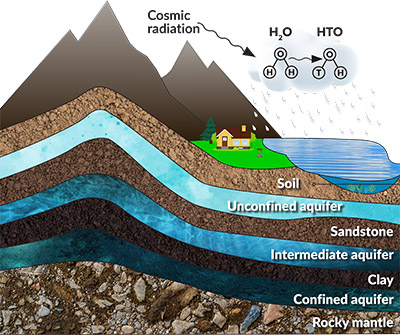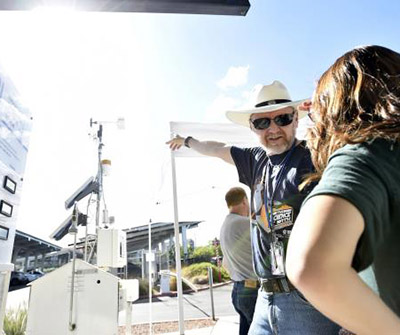About Us
Introduction
The Community Environmental Monitoring Program (CEMP) is a network of monitoring stations located in communities surrounding and downwind of the Nevada National Security Site (NNSS) that monitor the airborne and groundwater environments for manmade radioactivity that could result from NNSS activities. The CEMP is a joint effort between the Department of Energy’s National Nuclear Security Administration Nevada Field Office (NNSA/NFO), and the Desert Research Institute (DRI) of the Nevada System of Higher Education.
The network stations, located in Nevada, Utah, and California are comprised of instruments that collect a variety of environmental data. DRI employs local citizens to manage the stations. These Community Environmental Monitors (CEMs), many of whom are local science teachers, are responsible for monitoring the equipment, collecting scheduled air samples, and serving as points-of-contact for residents in their communities. They are also available to facilitate public outreach. Program funding and equipment are provided by NNSA/NFO. DRI manages the program, provides technical direction, employs and trains CEMs, conducts public outreach activities and prepares samples to be analyzed by an independent laboratory.
A Brief History of CEMP
In order to understand how the Community Environmental Monitoring Program (CEMP) came into being, it is helpful to become familiar with some of the history of nuclear research, development, and monitoring in the United States.
Air Monitoring
The CEMP monitors for airborne radioactivity and weather conditions and makes the results available to the public. Instruments that record these data are connected to a data logger, and real-time gamma radiation levels and weather conditions can be observed on interpretive signs located at the stations. The data are transmitted via landline or cellular phone, direct or wireless internet, or satellite transmission to DRI and information for most stations is updated in near real-time on a public website at cemp.dri.edu.
Public understanding of the CEMP and monitoring results is important, so great attention has been paid to station location and accessibility, and making the results available. DOE and DRI publish the results of the monitoring program and distribute these reports throughout the network community. The reports provide summaries of average values for each station and the entire network, and show deviations from the expected range values.

Each monitoring station is equipped with:
1. ANTENNA: The antenna transmits data to DRI’s WRCC where it is posted in near real-time to the CEMP website.
2. PARTICULATE SAMPLER: This air sampler pulls approximately two cubic feet of air per minute through a paper filter to capture airborne particles. The filter is collected regularly and analyzed by an independent laboratory for alpha, beta, and gamma radioactivity.
3. ENVIRONMENTAL DOSIMETER: This small device releases absorbed gamma energy in the form of light when stimulated by a special light emitting diode array in the laboratory. The amount of light released during this process is directly proportional to the gamma radiation the device has absorbed from background radiation while deployed at the CEMP station.
4. EXPOSURE RATE RECORDER: When gamma radiation passes through these recorders, the gas within the recorders is ionized causing an electrical pulse. The recorders count the pulses, which is converted into the amount of gamma radiation that is present.
5. TEMPERATURE AND HUMIDITY PROBE: This probe measures the ambient air temperature and relative humidity.
6. ANEMOMETER AND WIND VANE: The anemometer measures wind speed and the wind vane measures wind direction.
7. PYRANOMETER: This instrument measures the amount of solar radiation at the station.
8. BAROMETER: This instrument measures the barometric pressure at the station.
9. RAIN GAUGE: This instrument measures the precipitation at the station.
10. THERMOCOUPLE: This probe measures the temperature of the soil at the station.
Water Monitoring
The CEMP continues groundwater sampling that started in 2014, and is currently focusing efforts in areas down-gradient from the NNSS. DRI works with CEMs in these areas to identify community water sources, wells and springs that will be sampled for tritium.

Community Environmental Monitors (CEMs)
The CEMS are local residents trained through attendance at regular workshops conducted by NNSA/NFO and DRI to understand the results of the environmental monitoring. They become knowledgeable on subjects ranging from radiation detection to local environmental conditions. This enables them to participate in public outreach, and to better answer questions from their communities about the monitoring program and data results in their area and throughout the network.
CEMs are effective technical liaisons between local and federal entities, helping to identify the environmental concerns of people in their communities. All members of the public are invited to visit the stations and see the data.

Contact Information
U.S. Department of Energy
Nevada Operations Office
Office of Public Affairs and Information
P.O. Box 98518
Las Vegas, Nevada 89193-8518
Phone (702) 295-3521
Fax (702) 295-0154
E-mail: nevada@nnsa.doe.gov
https://nnss.gov
DRI – Southern Nevada Science Center
755 East Flamingo Road
Las Vegas, Nevada 89119
Phone (702) 862-5340
Fax (702) 862-5326
E-mail: Beverly.Parker@DRI.edu
www.dri.edu
